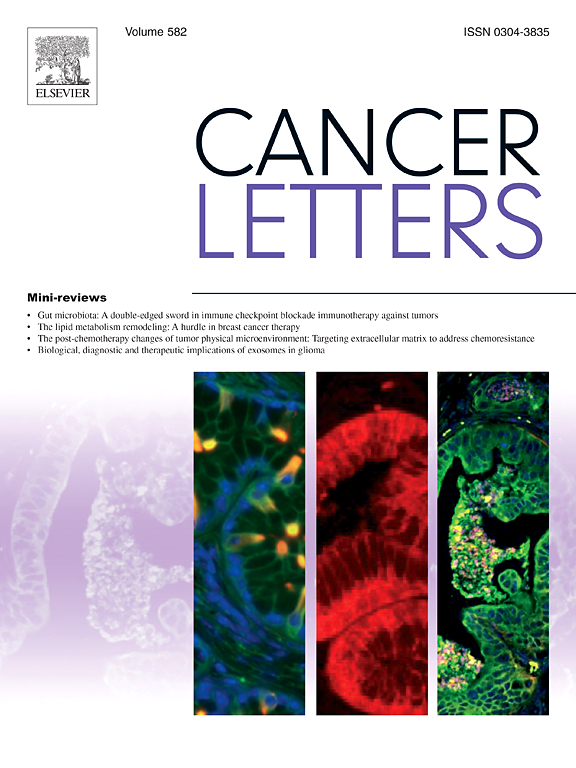类器官在胰腺肿瘤研究中的应用:培养、应用和局限性。
IF 10.1
1区 医学
Q1 ONCOLOGY
引用次数: 0
摘要
胰腺肿瘤主要分为胰腺导管腺癌(Pancreatic ductal adencarcinoma, PDAC)、胰腺神经内分泌肿瘤和胰腺囊性肿瘤。类器官技术作为一种三维体外培养模型,能够真实地模拟胰腺组织结构、细胞类型和肿瘤微环境,为胰腺肿瘤研究提供了创新工具。本文系统综述了类器官技术在胰腺肿瘤研究中的应用进展及面临的挑战。在方法层面,通过矩阵嵌入、气液界面、微流控芯片和悬浮培养等技术构建类器官模型。这些模型保留了肿瘤的分子特征和异质性,有效地解决了传统模型的局限性,如培养周期长和物种差异大。在研究应用方面,类器官技术在PDAC研究中广泛应用于组学分析、药物筛选、肿瘤微环境模拟等方面。该综述强调了这些领域的最新进展,重点是关键研究成果和正在进行的临床试验。尽管有其优势,类器官技术仍然遇到一些限制:肿瘤微环境成分的逐渐丢失,对Matrigel的严重依赖,获得足够和有代表性的患者样本的挑战,样本间异质性,非肿瘤细胞污染,以及目前缺乏标准化的培养方案。总之,通过精确地复制肿瘤的生物学特征,类器官技术已经成为一个强大的平台,大大推进了胰腺肿瘤的基础研究和临床治疗。本文章由计算机程序翻译,如有差异,请以英文原文为准。
Organoids in the research of pancreatic neoplasms: cultivation, applications, and limitations
Pancreatic neoplasms are mainly classified as pancreatic ductal adenocarcinoma (PDAC), pancreatic neuroendocrine neoplasms, and pancreatic cystic neoplasms. As a three-dimensional in vitro culture model, organoid technology can faithfully mimic the tissue structure, cell types, and tumor microenvironment, providing an innovative tool for pancreatic neoplasm research. This review systematically summarizes the application progress and challenges of organoid technology in pancreatic neoplasms research. At the methodological level, organoid models are constructed through techniques such as Matrigel embedding, air-liquid interface, microfluidic chips, and suspension culture. These models preserve the molecular characteristics and heterogeneity of neoplasms, effectively addressing the limitations of traditional models, such as long cultivation periods and significant species differences. In terms of research applications, organoid technology has been widely used for omics analysis, drug screening, and the simulation of the tumor microenvironment in PDAC studies. The review underscores recent advances in these areas, with a focus on key research findings and ongoing clinical trials. Despite its advantages, organoid technology still encounters several limitations: the progressive loss of tumor microenvironment components, heavy reliance on Matrigel, challenges in obtaining sufficient and representative patient samples, inter-sample heterogeneity, non-neoplastic cell contamination, and the current lack of standardized culture protocols. In conclusion, by accurately replicating the biological characteristics of tumors, organoid technology has emerged as a powerful platform that has significantly advanced both basic research and clinical treatments for pancreatic neoplasms.
求助全文
通过发布文献求助,成功后即可免费获取论文全文。
去求助
来源期刊

Cancer letters
医学-肿瘤学
CiteScore
17.70
自引率
2.10%
发文量
427
审稿时长
15 days
期刊介绍:
Cancer Letters is a reputable international journal that serves as a platform for significant and original contributions in cancer research. The journal welcomes both full-length articles and Mini Reviews in the wide-ranging field of basic and translational oncology. Furthermore, it frequently presents Special Issues that shed light on current and topical areas in cancer research.
Cancer Letters is highly interested in various fundamental aspects that can cater to a diverse readership. These areas include the molecular genetics and cell biology of cancer, radiation biology, molecular pathology, hormones and cancer, viral oncology, metastasis, and chemoprevention. The journal actively focuses on experimental therapeutics, particularly the advancement of targeted therapies for personalized cancer medicine, such as metronomic chemotherapy.
By publishing groundbreaking research and promoting advancements in cancer treatments, Cancer Letters aims to actively contribute to the fight against cancer and the improvement of patient outcomes.
 求助内容:
求助内容: 应助结果提醒方式:
应助结果提醒方式:


